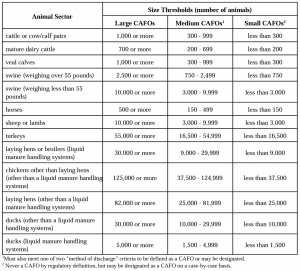This week, President Joe Biden’s administration rejected pleas from activists to intensify the regulation of concentrated animal feeding operations. Instead, the U.S. Environmental Protection Agency has decided to establish an advisory subcommittee to examine the issue better.
The two petitions, filed by environmental and community groups, issued concerns about the manure and “pollutants” they say are released into waterways. CAFO are already subject to inspections and a greater number of regulations than most other sectors of farming and ranching.
“A comprehensive evaluation is essential before determining whether any regulatory revisions are necessary or appropriate,” an agency statement said. In a letter to the groups, the EPA said that the panel will comprise agricultural representatives, environmental groups, researchers, and others to develop recommendations by 2024. They anticipate that the process will take 12 to 18 months.
The EPA’s new Animal Agriculture and Water Quality subcommittee will operate under the existing Farm, Ranch, and Rural Communities Committee.
Farms that are considered a CAFO, which was first formally defined by the federal government in 1976, can be designated as small, medium, or large. A large CAFO is considered to be any AFO with more than 1,000 animal units — with an “animal unit” defined as 1,000 pounds of live weight. So, if you have a million or more pounds worth of livestock you’re a large CAFO. That explains why a dairy farm needs only 700 cows to be considered a CAFO, but a turkey farmer needs 55,000 birds. Classifying by weight is considered the easiest way to standardize the system, especially because the EPA doesn’t necessarily care how many animals you have, it’s how much manure there is.

Following the announcement, the National Cattlemen’s Beef Association and the National Pork Producers Council issued statements thanking the EPA for supporting farms and ranches.
“NCBA appreciates the EPA recognizing that America’s farmers and ranchers are committed to ensuring clean water and investing in a sustainable future,” said NCBA Chief Counsel Mary-Thomas Hart. “By rejecting these two petitions that sought to directly attack animal agriculture, the EPA is protecting cattle producers from frivolous distractions and allowing them to return to the important job of stewarding our natural resources and feeding the nation.”
“Farmers work hard every day to adopt climate-smart farming practices by promoting soil health, conserving water, using nutrients efficiently, and caring for our animals,” wrote Scott Hays, NPCC president. “We are grateful for the Biden administration’s continuous commitment and support of agriculture. We look forward to working cooperatively with EPA and all stakeholders as we continue to work to preserve and protect our farms and lands for future generations.”
The original petition filed by Food and Water Watch, Center for Food Safety, and others in 2017 asked the EPA to change CAFO regulations. In 2022, another lawsuit was filed under the U.S. Court of Appeals; in response, the EPA agreed to a court-approved deadline to respond to the 2017 petition by August 2023.
In addition, the EPA is issuing a response to a second petition that the Agency received at the end of 2022 regarding CAFO regulations.
»Related: Senate bill aims to eliminate all CAFOs in 20 years


